
What Is the Best Use of Gantt Charts for Marketing Planning?
A Gantt chart is a popular project management tool that visually represents the timeline of a project. It displays tasks or activities along the horizontal axis and time along the vertical axis so that teams can clearly understand schedules, dependencies, and progress.
Gantt charts help companies plan marketing campaigns. Here are the best Gantt charts for marketing strategy planning:
- Timeline visualization.
- Task management.
- Resource allocation.
- Coordination and collaboration.
- Task delegation.
Professionals, such as a marketing strategy consultant, use Gantt charts to develop concrete marketing plans. Find out how this tool can help with your business marketing planning.
Let’s go!
Watch this video to find out more about how Digital Authority Partners can create a great marketing strategy for you!
Visualize Project Timelines
Gantt charts play a pivotal role in business marketing planning, thanks to their capability to present project timelines in a visual format. They offer teams a bird's-eye view of all tasks, milestones, and deadlines. The benefits are:
- Task dependencies: Understand which tasks are interlinked and in what sequence they should be executed.
- Problem identification: Spot issues in the timeline or task dependencies early, allowing for swift resolution.
- Resource allocation: Make informed decisions about distributing resources based on task durations and dependencies.
- Team collaboration: Enhance communication among team members, making the path to marketing objectives more cohesive.
For a real estate firm planning a new housing development, a Gantt chart can show the following information:
| Task/Milestone | Start Date | End Date | Duration (Days) | Dependency |
|---|---|---|---|---|
| Market Research | Jan 1, 2024 | Jan 15, 2024 | 15 | None |
| Develop Marketing Strategy | Jan 16, 2024 | Feb 1, 2024 | 17 | Market Research |
| Create Promotional Material | Feb 2, 2024 | Feb 16, 2024 | 15 | Develop Marketing Strategy |
| Launch Online Campaign | Feb 17, 2024 | Mar 3, 2024 | 15 | Create Promotional Material |
| Open House Event 1 | Mar 4, 2024 | Mar 5, 2024 | 2 | Launch Online Campaign |
| Evaluate First Open House | Mar 6, 2024 | Mar 10, 2024 | 5 | Open House Event 1 |
| Open House Event 2 | Mar 11, 2024 | Mar 12, 2024 | 2 | Evaluate First Open House |
| Finalize Sales | Mar 13, 2024 | Apr 13, 2024 | 31 | Open House Event 2 |
| Post-Sales Evaluation | Apr 14, 2024 | Apr 21, 2024 | 8 | Finalize Sales |
In a Gantt chart tool, these tasks would appear as horizontal bars spanning from their respective start dates to end dates. Arrows could can dependent tasks, helping to visualize the flow of activities and milestones.
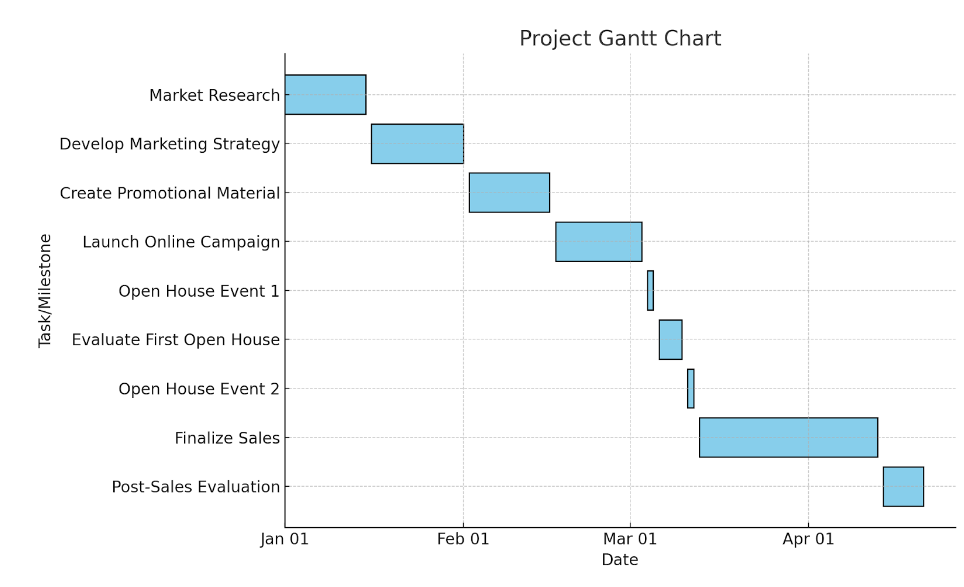
This makes it easier to see at a glance:
- How long each task is estimated to take.
- When each task is set to begin and end.
- Which tasks are dependent on the completion of prior tasks.
By using this table as a foundation for a Gantt chart, the real estate firm gains the following:
- Comprehensive overview. Every marketing activity, duration, and dependencies are clearly laid out.
- Strategic insight. The team can spot potential overlaps or scheduling gaps, making it easier to make timely adjustments to the marketing strategy.
- Alignment with overall goals. This ensures that all marketing efforts synchronize with the project's larger timeline, culminating in well-timed property sales.
Simplify Task Management
Gantt charts simplify task management planning because they intuitively visualize project timelines. Marketing strategy consultants use Gantt charts to give marketing teams a clear and concise representation of tasks, durations, and corresponding dependencies.
Improving a comprehensive overview of the entire project, Gantt charts enable marketers to prioritize tasks effectively and make informed decisions about resource allocation. Marketers can facilitate progress monitoring, allowing for timely adjustments and making sure that tasks are completed within the set time frame.
Take the following data for an event, for instance:
| Task | Start Date | End Date | Duration (Days) |
|---|---|---|---|
| Venue Booking | Nov 1, 2023 | Nov 7, 2023 | 6 |
| Vendor Coordination | Nov 8, 2023 | Nov 14, 2023 | 6 |
| Advertising | Nov 15, 2023 | Nov 21, 2023 | 6 |
| Social Media Promotion | Nov 15, 2023 | Nov 21, 2023 | 6 |
With a Gantt chart, team members can prioritize activities and allocate resources, ensuring that no aspect of the event is overlooked. They are able to quickly track task progress and identify any potential delays.
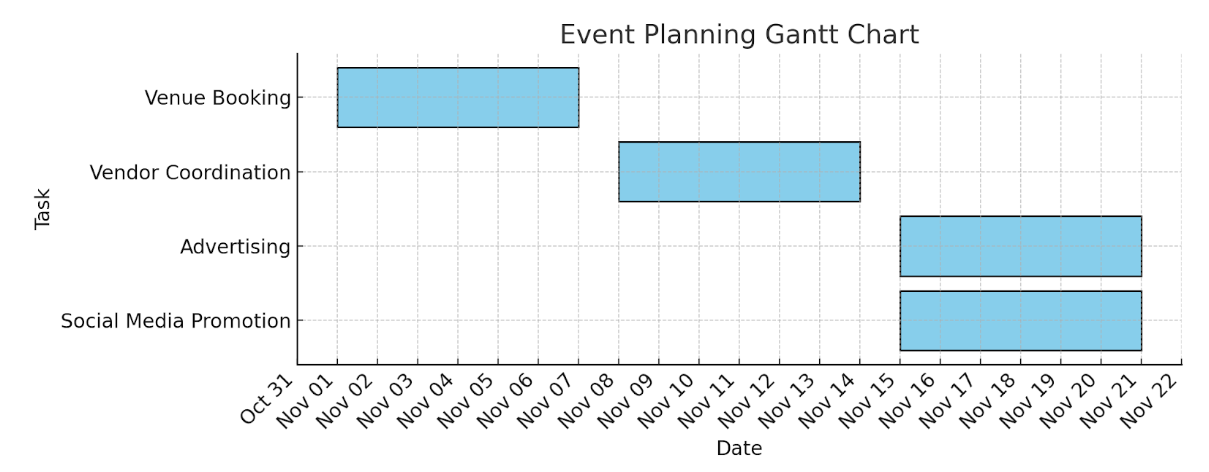
Improve Resource Allocation
Gantt charts can improve resource allocation in marketing planning. These provide a clear visual representation of project timelines and task dependencies to help marketers identify high and low activity periods. This helps allocate resources more effectively, to make certain that the right resources are available at the right time.
Additionally, Gantt charts facilitate the identification of potential resource conflicts or overloads. This allows the marketing strategy expert to proactively adjust to prevent bottlenecks and delays. Gantt charts also contribute to optimizing the utilization of resources and enhancing overall project efficiency in marketing campaigns.
Here is an example of a table with resource requirements:
| Task | Start Date | End Date | Duration | Resources Required |
|---|---|---|---|---|
| Venue Booking | Nov 1 | Nov 7 | 6 days | Event Planner, Contract Manager |
| Venue Coordination | Nov 8 | Nov 14 | 6 days | Event Planner, Vendor Liaison, Budget |
| Advertising | Nov 15 | Nov 21 | 6 days | Marketing Team, Graphic Designer, Ad Budget |
| Social Media Promotion | Nov 15 | Nov 21 | 6 days | Social Media Manager, Content Creator |
With this enhanced Gantt chart, a team could see not only when tasks need to be completed but also what and who is required to complete them. They can plan to ensure that resources are available and identify periods when additional resources might be needed. It is a central planning tool that aligns the project schedule with resource management.
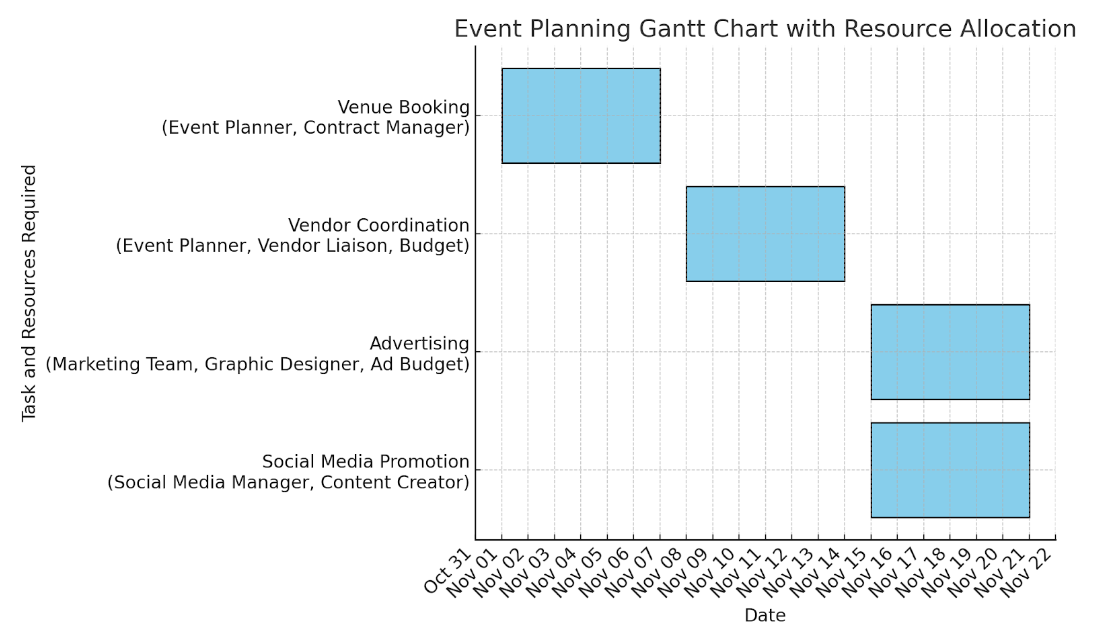
Support Coordination and Collaboration
Gantt charts support coordination and collaboration within marketing planning. They provide a shared visual roadmap for all team members, fostering a common understanding of project timelines and objectives.
By illustrating task interdependencies and progress, these tools promote communication among team members, facilitating a cohesive and coordinated approach to marketing. Gantt charts enable real-time updates and adjustments, allowing team members to stay informed about changes and contribute actively to collective progress.
Arrows or lines connecting various tasks in a Gantt chart often serve to represent interdependencies. These visual connectors illustrate the relationship between tasks, typically indicating that one task cannot commence until another has been completed. The updated Gantt chart below includes red arrows that illustrate the dependencies between tasks:
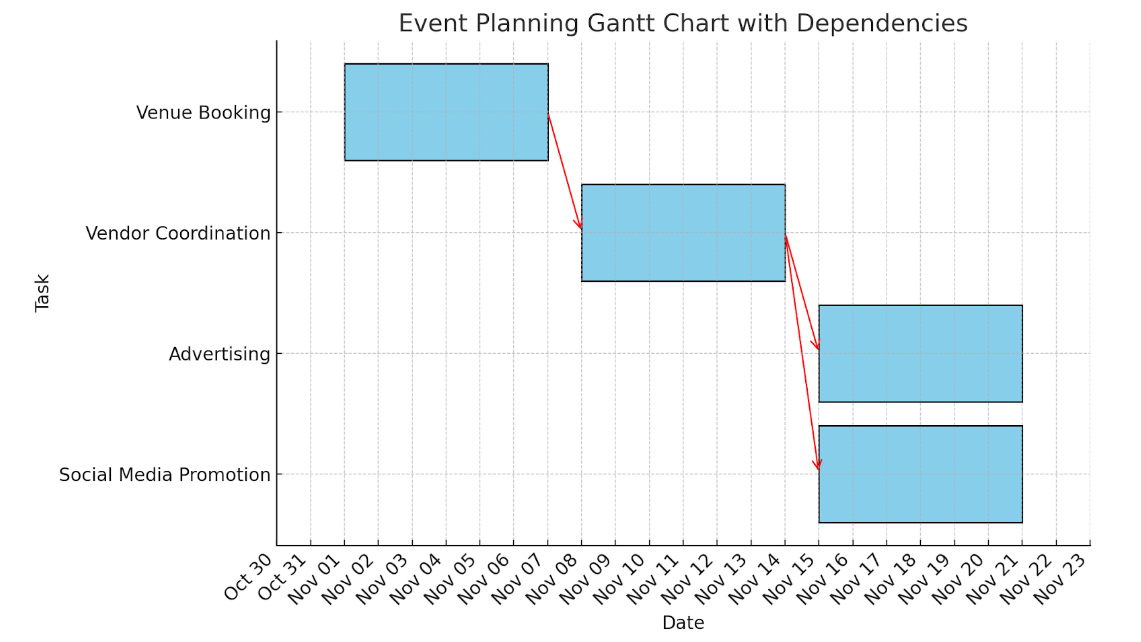
An arrow from the end of "Venue Booking" to "Vendor Coordination" indicates that the coordination can only start once the venue has been booked. Arrows from the end of "Vendor Coordination" to the start of both "Advertising" and "Social Media Promotion" indicate that these tasks depend on the completion of vendor coordination.
Help with Task Delegation
Gantt charts male project delegation more efficiently by visually mapping out project timelines and tasks, aiding in task assignments based on individual skills and availability. They enable managers to allocate resources, preventing overburdening team members and ensuring equitable work distribution.
Because of their ability to monitor task progress, Gantt charts allow timely adjustments and interventions, making sure that the project stays on track. Charts serve as a shared visual reference to enhance communication among team members, fostering a clear understanding of responsibilities and deadlines.
Gantt charts streamline project delegation, leading to effective coordination, optimized resource utilization, and successful delivery. You can use color-coding, labels, or legends to indicate task delegation. The updated Gantt chart below now includes both color coding and labels to indicate task delegation:
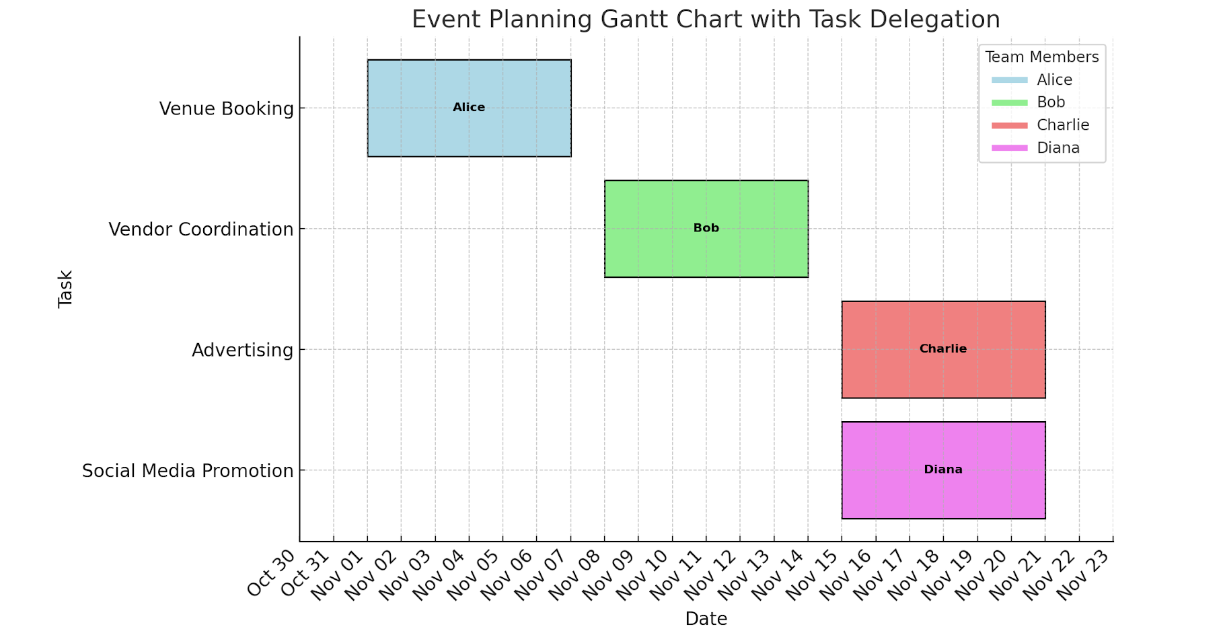
Each color represents a different team member responsible for the task. The name of the team member is also labeled on the taskbar itself for clear identification.
With this chart, it is easy to see at a glance who is responsible for each task and when they are scheduled to work on it. The legend on the side provides a quick reference to associate colors with team members.
Summing Up
Using a Gantt chart helps companies with marketing planning, especially timeline visualization, task management, resource allocation, coordination, and collaboration in marketing planning. Businesses can ease marketing planning by partnering with a trusted marketing strategy consultant, paving the way for effective campaigns.
Find out how Gantt charts and other marketing visualization tools can help your business. Contact Digital Authority Partners (DAP) today.
Want To Meet Our Expert Team?
Book a meeting directly here




